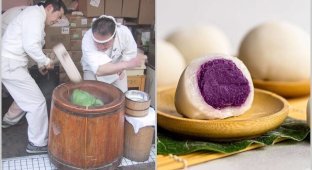Why do the most beautiful women in Japan hunt sumo wrestlers? (10 photos)
Many people tend to believe that athletic and muscular men are the epitome of physical attractiveness for women. This belief makes millions of men around the world spend years in the gym, working on creating a toned and sculpted body in order to win the attention of the opposite sex. 
But can you imagine that in Japan, the most beautiful, successful and desirable women often strive to win the attention of not slender athletes, but sumo wrestlers?
Sumo is a traditional Japanese sport where two athletes with impressive dimensions, wearing a mawashi belt, try to push each other out of the ring. 
At first glance, the combination of the fragile beauty of Japanese models, actresses and singers with the massive figure of sumo wrestlers may seem unexpected. But many famous sumo wrestlers are actually married to real stars.
For example, the wife of sumo wrestler Takanohana Koji is a popular TV presenter and one of the most beautiful women in Japan, for whose hand many famous actors and businessmen have fought, the wife of wrestler Toyanoshima is a professional model and the holder of the title "Miss Kyoto", and the famous champion Hakuho is married to a very famous Japanese figure skater.
So why do sumo wrestlers have such overwhelming popularity among beautiful women?
First, a brief excursion into the history of sumo 
Sumo wrestlers in the company of a geisha
Sumo has its roots in Japanese mythology, when there was a struggle between the gods Takemikazuchi (the god of thunder and sword) and Takeminakata (the god of water, hunting and war) for the right to possess Japan. This competition became a symbol of the sacred contest of strength.
It was these myths that formed the basis of sumo rituals, which in Shintoism were held annually as sacred rites.
Shintoism is the original religion of Japan and is more of a set of sacred rituals and ceremonies than a belief system or a specific code of ethics. The word itself means "the way of the gods." Thus, like many other rituals in Japan, sumo was originally performed to entertain the gods (kami) during festivals (matsuri), as well as to appease the spirits and ensure a bountiful harvest. 
During the Nara period (710–794) and the Heian period (794–1185), sumo gradually lost its religious character and became a regular fight between rikishi (sumo wrestlers) as entertainment for the elite, held at the imperial court.
Back then, fights were not regulated by strict rules and often ended in the death of one of the participants.
With the advent of the samurai era, sumo wrestling acquired military significance. 
According to the Shincho Koki document (circa 1610), the legendary warlord Oda Nobunaga was a great fan of sumo and held annual tournaments where the winners were awarded glory, honors, and even land. During this period, wealthy daimyo (landowners) began to sponsor wrestlers, and the most successful of them could even achieve samurai status.
During the Edo period (1603–1867), sumo became closer to the sport we know today. From being a pastime for aristocrats, wrestling turned into a spectacle for the masses. Wrestlers began to form groups and schools. It was during this time that the basic rules and standards were developed, many of which remain in place to this day.
At this time, strict rules appeared in sumo: 48 kimarite (allowed and prohibited techniques), the fights themselves were no longer held to the death. Now the victory was counted if one of the participants was outside the ring or touched the floor with any part of the body except the feet. These changes affected the physical training of the wrestlers. 
After all, if before the Edo period sumo wrestlers relied on strength and endurance, then the new rules encouraged them to increase their body weight in order to gain an advantage in pushing an opponent out of the ring. It was then that the tradition of sumo wrestlers gaining impressive size began.
Bright and colorful ceremonies such as dohyo-iri (ritual entrance to the arena) also appeared, which have survived to this day.
But let's get back to the topic of our article: why do modern Japanese women adore sumo wrestlers? 
For the Japanese, sumo is not just a sport where two heavyweights try to push each other out of the ring. It is an ancient tradition filled with sacred meaning and religious overtones. Sumo for the Japanese can be compared to the Olympic Games for the ancient Greeks - a symbol of national pride and cultural heritage.
Because of this, sumo wrestlers have 3 clear advantages (which make them enviable men):
1. High social status 
Sumo wrestlers occupy a special place in Japanese society.
Successful athletes enjoy great respect, regularly meet with the country's leadership and the imperial family, and also become frequent guests at elite events.
All the main annual state banquets, holidays and ceremonies - sumo stars receive personal invitations to these events, which emphasizes their exceptional status in Japan.
2. Solid income 
High status inevitably comes with significant income.
Sumo is a state-supported sport, so successful wrestlers receive decent compensation. The monthly income of major league athletes ranges from 1 to 6 million yen, and sumo superstars earn up to 400 million yen, including endorsements.
With such prospects, it is not surprising that sumo wrestlers become objects of admiration among beautiful women who dream of connecting their lives with a man of high status, and also with a high income.
3. A special character 
To become a sumo wrestler, physical strength is not enough. An athlete must have outstanding personal qualities: calmness, broad outlook, modesty, high morality and wisdom.
Top-level sumo wrestlers are required to avoid any public scandals, maintaining the reputation of their sport and personal name.
Sumo wrestlers are even prohibited from driving a car, so as not to accidentally cause an accident and not tarnish their public image and reputation.
For Japanese women, marriage to such a man is not only an opportunity to be with a person of high social status, but also a chance to emphasize their own prestige. After all, the wife of a sumo wrestler is the embodiment of an ideal companion, possessing a character worthy of admiration.
It is not surprising that sumo wrestlers, who combine strength, status and wisdom, cause such delight in Japanese women.






























